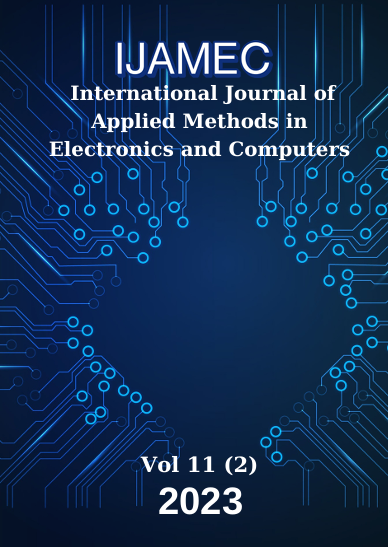Evaluation of the performance of an unmanned aerial vehicle with artificial intelligence support and Mavlink protocol designed for response to social incidents response
DOI:
https://doi.org/10.18100/ijamec.1216914Keywords:
Drone, Artificial Intelligence, UAV, Autonomous Flight, AircraftAbstract
The unmanned aerial vehicle name is TOMHA, which was developed to be used in the response of social incidents, aims to support the operational activities of security forces in response to social incidents, to expand their domination areas, to detect incidents that may disturb social peace in advance and to provide rapid intervention with the new unmanned aerial vehicle technologies developed. The scope of the TOMHA system designed was kept comprehensive compared to other unmanned aerial vehicles and the scope includes intervention to social events, ordering in local administrations, defense, reconnaissance and attack activities in military operations, inspections arranged for public interest, AFAD and service areas, forest fires detection and intervention, and public order operations. This TOMHA is being developed using the Pixhawk flight control card and the jetson nano artificial intelligence card. In addition to these cards, it has the feature of manual or artificial intelligence supported autonomous flight thanks to GPS, telemetry, FPV transceiver module, camera systems and national software to be used. It is controlled through the controller using RC communication channel for manual use. TOMHA has a flight time of 13.6 minutes, a thrust of 4.45G and a speed of 78 km and a mileage of 4993 meters in optimum conditions. The findings obtained by the tests performed with the designed TOMHA prototype show similar results with the literature. Thanks to the national design, TOMHA stands out when it encounters other unmanned aerial vehicles. It is seen that the response of the system to the sudden changes caused by the maneuver movements in the simulation environment is very fast and it follows the changes.Downloads
References
S. Murat, “İnsansız Hava Aracı Görüntülerinden Derin Öğrenme Yöntemleriyle Nesne Tanıma,” M. Eng. thesis, Maltepe Institute of Science, İstanbul, Turkey, Feb. 2021.
TÜBAV, “Real-Time Vehicle Detection By Using Deep Learning Methods,” 2020.
K.E. Kolaylı, A. Bayraktar, G. Durmuş, A. Altıntaş, “Göklerin Hâkimi Teknofest İstanbul Havacılık, Uzay ve Teknoloji Festivali Savaşan İha Yarışma Kritik Tasarım Raporu,” 2021.
P. Kumar, S. Batchu, N. Swamy S. and S. R. Kota, "Real-Time Concrete Damage Detection Using Deep Learning for High Rise Structures," in IEEE Access, vol. 9, pp. 112312-112331, 2021, doi: 10.1109/ACCESS.2021.3102647.
A. Kaçar, “Üç Dönerkanatlı ve Döner-Rotorlu İnsansız Hava Aracının Tasarımı,” Tech. Rep., 2013.
E. Avşar, M. Yalçın, N. Boran, and Z. Ay,. “Döner Kanatlı İnsansız Hava Aracı Tasarımı,” Tech. Rep., 2021.
A. Akbulut, E. Ömer, F. Er, and B. Sofu, “Ankara Üniversitesi Bilimsel Araştırma Projesi Sonuç Raporu,” 2016.
Ş. Yıldırım , N. Çabuk ve V. Bakırcıoğlu , "Alti Rotorlu Ve Sekiz Rotorlu İnsansiz Hava Araçlarinin Farkli Bozucu Etki Altinda Uçuş Performanslarinin Karşilaştirilmasi", Konya Journal of Engineering Sciences vol. 8, pp. 552-562, 2020, doi:10.36306/konjes.594701
Y. T. Wu, Z. Qin, A. Eizad, and S. K. Lyu, “Numerical İnvestigation of the Mechanical Component Design of a Hexacopter Drone for Real-Time Fine Dust Monitoring,” Journal of Mechanical Science and Technology, vol. 35, no. 7, pp. 3101–3111, Jul. 2021, doi: 10.1007/s12206-021-0632-y.
A. Demirtaş, “Döner Kanatlı İnsansız Hava Araçları ile Görsel Verilere Dayalı Erken Yangın Algılama Sistemi,” Ankara University, Institute of Science, Ankara, Turkey, 2019.
R. Çömert, “Uluslararası Deprem Mühendisliği ve Sismoloji Konferansı,” 2017. Available: http://www.tdmd.org.tr/TR/Genel/4UDMSK/pdf2017/3858.pdf
K. Ramesh, B. Priya Dharshini, K. Haridass, S. Deepak Kumar, R. Gokul Raj, and V. Hariprasad, “Sanitization using Hexacopter Autonomous Drone,” in IOP Conference Series: Materials Science and Engineering, Feb. 2021, vol. 1059, no. 1. doi: 10.1088/1757-899X/1059/1/012043. Available: https://iopscience.iop.org/article/10.1088/1757-899X/1059/1/012043/pdf
D. Lee, W. Gyu La and H. Kim, "Drone Detection and Identification System using Artificial Intelligence," 2018 International Conference on Information and Communication Technology Convergence (ICTC), 2018, pp. 1131-1133, doi: 10.1109/ICTC.2018.8539442.
C.Y. Taş, “Teknofest İstanbul Havacılık, Uzay ve Teknoloji Festivali Savaşan İha Yarışması,” 2019. Accessed: Nov. 03, 2021. [Online]. Available: https://teknofest.org/pdfler/savasan_iha_yar%C4%B1smas%C4%B1_doner_kanat_blackb%C4%B1rd_iha_tak%C4%B1m_raporu.pdf
L. Meier, P. Tanskanen, F. Fraundorfer and M. Pollefeys, "PIXHAWK: A system for autonomous flight using onboard computer vision," 2011 IEEE International Conference on Robotics and Automation, 2011, pp. 2992-2997, doi: 10.1109/ICRA.2011.59802
Downloads
Published
Issue
Section
License
Copyright (c) 2023 International Journal of Applied Methods in Electronics and Computers

This work is licensed under a Creative Commons Attribution-ShareAlike 4.0 International License.





